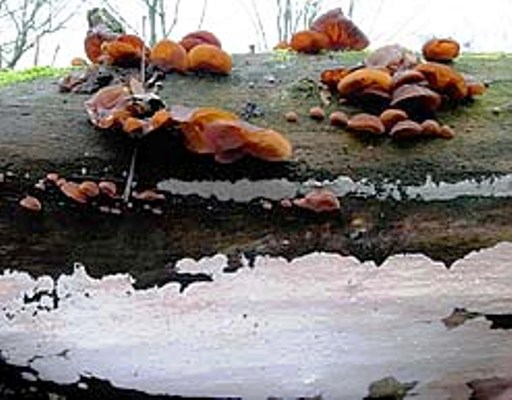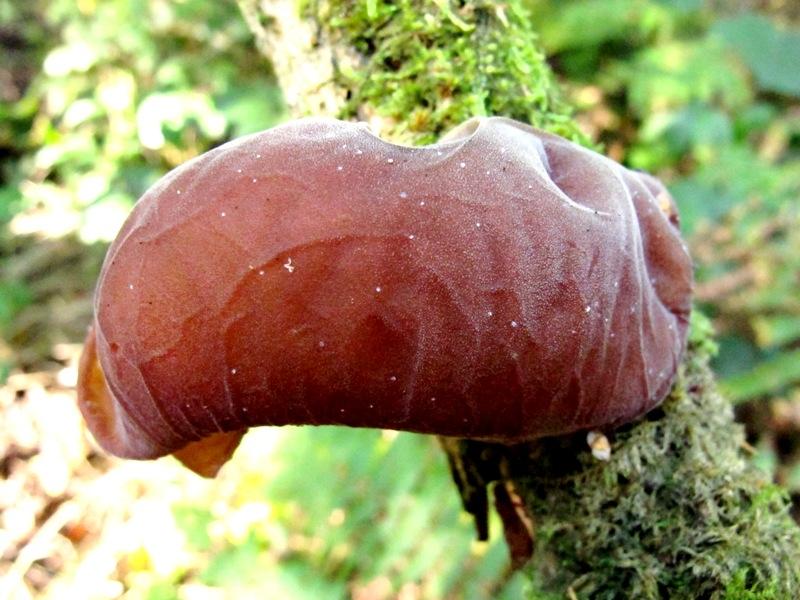Interactions
They are everywhere. At home. At school. At work. We continually form bonds with other people without even realizing it. It's inevitable. Fungi do the same thing. However, it's not the same way as it is for us. Let explore this concept.
©D.Humphries/arbtalk.com
To begin with, we have this fungus that acts as a saprophyte to dead wood of many different trees. Its primary host is the Sambucus niagra which is commonly known as the black elderberry tree. Aside from that, it is a saprophyte to other trees such as the Fagus sylvatica L. (European beech,) Acer campestre (Field Maple,) and Cornus sanguinea (Bloodtwig dogwood.) By being able to decompose the dead wood of these trees, it is able to leave nutrients in the soil that other plants can take up for their growth and benefit. Aside from that, during the decomposing process, the fungus releases carbon dioxide which is used by the plants for their food production.
Aside from these fungi being saprophytes, other organisms for associations with this fungus such as the Itersonilia perplexans which is associated with the fruiting body of the wood ear fungi. This organism is known to cause "Chrysanthemum pedal blight" and also leaf blight of both dill and coriander. It is considered a parasite to most plants (Storey, 2009.) Aside from that it is characterized by its ballistospore which is when the spore are literally shot off into a distance from the gill of the fungus just like the hat thrower fungus (Pilobolus crystallinus.) The spores on their own can be shot off quite a far distance due to the pressure built up behind them. Then the wind and other environmental factors take care of getting it further away from the original source.
©D.Humphries/arbtalk.com
Not only are trees and other fungi associated with the jelly ear fungus, but humans are also helped through the various medicinal attributes this fungus possesses. First of all, in China this mushroom has been used for quite some time as a remedy to treat certain health issues for centuries. The Chinese ginseng is also used in China to treat different ailments. Most mushrooms have polysaccharides in their fungal wall that acts in adding more support to their cell walls. These polysaccharides are the ones responsible for providing the medical ailments and most are also being researched today to find any future cures to medical issues that are present in many people.
In a food research program conducted by the Chinese University of Hong Kong, they researched these polysaccharides and discovered that the ones found in the Auricularia auricula-judae as well as in other species have antitumor properties. There have been about three decades of research on the isolated properties of mushrooms like this and how they could benefit the medical field. This following image shows Pectic acid which is one of the polysaccharides that were extracted from this mushroom.
Aside from that, it has blood clotting properties by blocking the platelets. In some cases, people have had internal bleeding due to the fact that they ate too much of the Hot and Sour soup (Paassen, 2010.)
Not only do they have antitumor properties, but they also might have some anticancer capabilities. Currently, there is research being conducted to determine how this could help cancer patients.
The polysaccharides of mushrooms like the jelly ear are attributed to many ailments, however not much has done on how it relates to the Jelly fungus. Although, the anticancer attributes have been researched as well as hypoglycemic effects to aid diabetics.
In other sources, it is mentioned that this mushroom is also used to aid in strengthening the body and also with hemorrhoids just like St.John's Wort (House, 2011.) Aside from that
There is so much that this mushroom has to contribute to human. I am sure that this along with other mushrooms is used for the research of a lot of current common illnesses that have harmed a lot of people and families. The research is never ending and most definitely needed.
Now that you have learned about the ways this mushroom interacts with other organisms, let's find out about some interesting facts about this mushroom along with some misconceptions that have accompanied this Jelly Ear.
Go Back to the Home Page.
 Auricularia
auricula-judae
Auricularia
auricula-judae 

